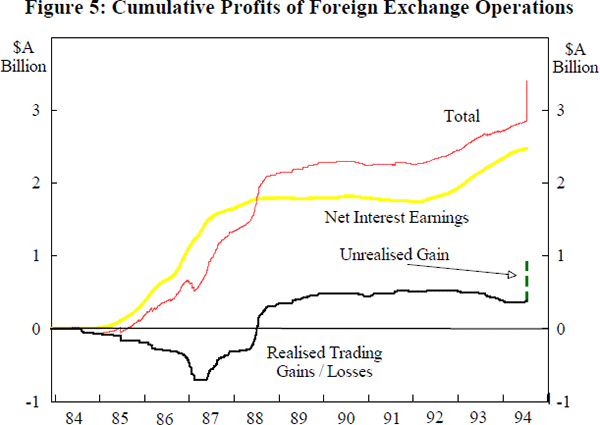RDP 9406: Reserve Bank Operations in the Foreign Exchange Market: Effectiveness and Profitability 4. Empirical Results
November 1994
- Download the Paper 128KB
Figure 5 shows the accumulation of total profits and its components – realised trading profits, the sum of realised and unrealised trading profits and net interest earnings – between the float and June 1994.

In the first few years of the float, realised trading losses were made. The Australian dollar depreciated sharply through this period. The Bank was mainly a seller of foreign exchange but it did also make some purchases from time to time. The cost of these purchases was on average higher than the price at which the Bank was selling, thus realising trading losses.[13] This process continued until end 1986. Thereafter, as the Australian dollar appreciated, the Bank became a net buyer of foreign currency and started to close out the net short position built up in the previous three years. The price at which the Bank was buying through this period was below the average price at which the short position had been established, so profits were realised. By October 1988, when the US dollar short position was finally closed out, realised trading profits stood at $A306 million, with a further $A1.9 billion in net interest earnings.
Over the next few years, the exchange rate moved within a relatively narrow band and the Bank built up a small long position. Realised profits through this period were relatively modest. Subsequent sales of foreign currency have once again opened up a short foreign currency position amounting to $US14.8 billion at June 1994. This has not had much impact on realised profits; at June 1994, cumulative realised profits since the float stood at $A382 million.
Realised gains are one component of profits from intervention. As shown in Table 1, another component is unrealised gains. At June 1994, the short foreign currency position the Bank was holding had resulted in substantial unrealised gains amounting to $A553 million. These reflect the difference between the average exchange rate at which the short position was accumulated (US71.10 cents) and the exchange rate at end June (US73.04 cents) which is used to revalue the position. The other component of profits – net interest earnings – have also been substantial in recent years, and the cumulative total of such earnings since the float is $A2,478 million. Adding all three components, total profits from intervention since the float have amounted to $A3,414 million.[14]
| Realised gains | 382 |
|---|---|
| Unrealised gains | 553 |
| Net interest earnings | 2,478 |
| Total | 3,414 |
Footnotes
These trading losses contrast with the accounting profits reported in the Bank's accounts at this time. Most of the intervention the Bank undertook immediately post float involved the sale of foreign exchange which had been acquired prior to the float when the Australian dollar was stronger and the cost of foreign exchange therefore lower. The sale of this foreign exchange, at prices which were above cost, realised profits in the Bank's accounts. In this study, which looks only at operations since the float, the cost of foreign exchange acquired before the float is not taken into account; it compares receipts from sales of foreign exchange only with the cost of purchases of foreign exchange since the float. [13]
These profits represent only the revenue earned by the Bank as a result of intervention. The Bank also earns regular interest income on its holdings of reserves. Over the period since the float, total earnings on reserves have amounted to around $US8 billion. [14]